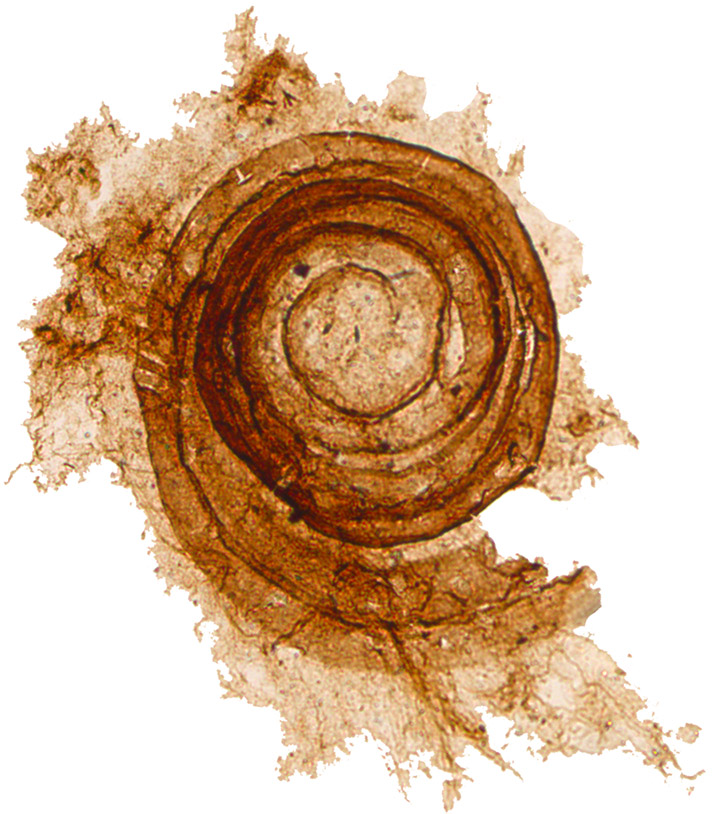|
Melanosclerite
The Melanosclerites are a group of problematic microfossils obtained by palynological processing. Morphology The form-taxon contains a wide array of rod-like fossils, 100 μm to some mm long, that culminate in a broad bulbous 'head', often separated from the stalk by a constriction. The bulbous end may bear broad 'prongs', giving the appearance of the end of a human femur where the prongs are paired, although the prongs often occur in higher number – five, six, a dozen – with some resemblance to ''Namacalathus''. Affinity The affinity of melanosclerites is uncertain; algal has been proposed, but hydrozoan (cnidarian) is preferred, though not conclusively established. ''Melanoscleritoites'' Eisenack, 1963 is interpreted as a hydrozoan, with other taxa not attributable to that particular class, on the basis of a broad morphological similarity – though the distinguishing features are far from unequivocal, and the preservation of the material raises some taphonomic ... [...More Info...] [...Related Items...] OR: [Wikipedia] [Google] [Baidu] |
Microfossil
A microfossil is a fossil that is generally between 0.001 mm and 1 mm in size, the visual study of which requires the use of light or electron microscopy. A fossil which can be studied with the naked eye or low-powered magnification, such as a hand lens, is referred to as a macrofossil. Microfossils are a common feature of the geological record, from the Precambrian to the Holocene. They are most common in deposits of marine environments, but also occur in brackish water, fresh water and terrestrial sedimentary deposits. While every kingdom of life is represented in the microfossil record, the most abundant forms are protist skeletons or microbial cysts from the Chrysophyta, Pyrrhophyta, Sarcodina, acritarchs and chitinozoans, together with pollen and spores from the vascular plants. Overview A microfossil is a descriptive term applied to fossilized plants and animals whose size is just at or below the level at which the fossil can be analyzed by the naked eye. A ... [...More Info...] [...Related Items...] OR: [Wikipedia] [Google] [Baidu] |
Palynological Processing
Palynology is the "study of dust" (from grc-gre, παλύνω, palynō, "strew, sprinkle" and ''-logy'') or of "particles that are strewn". A classic palynologist analyses particulate samples collected from the air, from water, or from deposits including sediments of any age. The condition and identification of those particles, organic and inorganic, give the palynologist clues to the life, environment, and energetic conditions that produced them. The term is commonly used to refer to a subset of the discipline, which is defined as "the study of microscopic objects of macromolecular organic composition (i.e., compounds of carbon, hydrogen, nitrogen and oxygen), not capable of dissolution in hydrochloric or hydrofluoric acids". It is the science that studies contemporary and fossil palynomorphs (paleopalynology), including pollen, spores, orbicules, dinocysts, acritarchs, chitinozoans and scolecodonts, together with particulate organic matter (POM) and kerogen found in sed ... [...More Info...] [...Related Items...] OR: [Wikipedia] [Google] [Baidu] |
Namacalathus
''Namacalathus'' is a problematic metazoan fossil occurring in the latest Ediacaran. The first, and only described species, ''N. hermanastes'', was first described in 2000 from the Nama Group of central and southern Namibia. A U–Pb zircon age from the fossiliferous rock in Namibia and Oman provides an age for the ''Namacalathus'' zone in the range from 549 to 542 Ma, which corresponds to the Late Ediacaran. Alongside ''Namapoikia'' and '' Cloudina'', these organisms are the oldest known evidence in the fossil record of the emergence of calcified skeletal formation in metazoans, a prominent feature in animals appearing later in the Early Cambrian. Shore ''et al.'' (2021) reported the first three-dimensional, pyritized preservation of soft tissue in ''Namacalathus hermanastes'' from the Nama Group (Namibia), and evaluate the implications of this finding for the knowledge of the phylogenetic relationships of this animal; they suggest it is an ancestor of Lophotrochozoan animals su ... [...More Info...] [...Related Items...] OR: [Wikipedia] [Google] [Baidu] |

